Brief

While China and countries around the world confront the human toll from the coronavirus outbreak, the effect on China’s food industry is already coming into focus.
Travel restrictions and quarantines after the outbreak were apparent immediately. Restaurants sat empty, and home deliveries spiked as customers shunned eating out in favor of ordering in. Animal slaughtering and processing operations slowed considerably amid travel and workplace shutdowns and reduced demand.
More broadly, the coronavirus, which rapidly spread from an outdoor market selling live animals and fresh meat in the city of Wuhan, is poised to dramatically change those very markets, which many Chinese rely on for fresh meat. A look into the history of China’s meat industry underscores the need for a transformation away from these open-air markets and toward a cold-chain model, similar to Europe and the United States, that keeps perishable items fresher for longer.

Macro Surveillance Platform
For more detail on the business implications of coronavirus from Bain’s Macro Trends Group, log on to the Macro Surveillance Platform. Learn more about the platform >
Lessons from past outbreaks
China is no stranger to epidemic-induced food chain disruptions. Bird flus such as H7N9 in 2017 affected chicken stocks, while the African swine fever in 2018–2019 led to a pork shortage that lingers today.
Perhaps most comparable to the COVID-19 epidemic is the 2002–2003 SARS outbreak, which can provide some lessons for how quickly the industry may recover once the outbreak abates (see Figure 1).
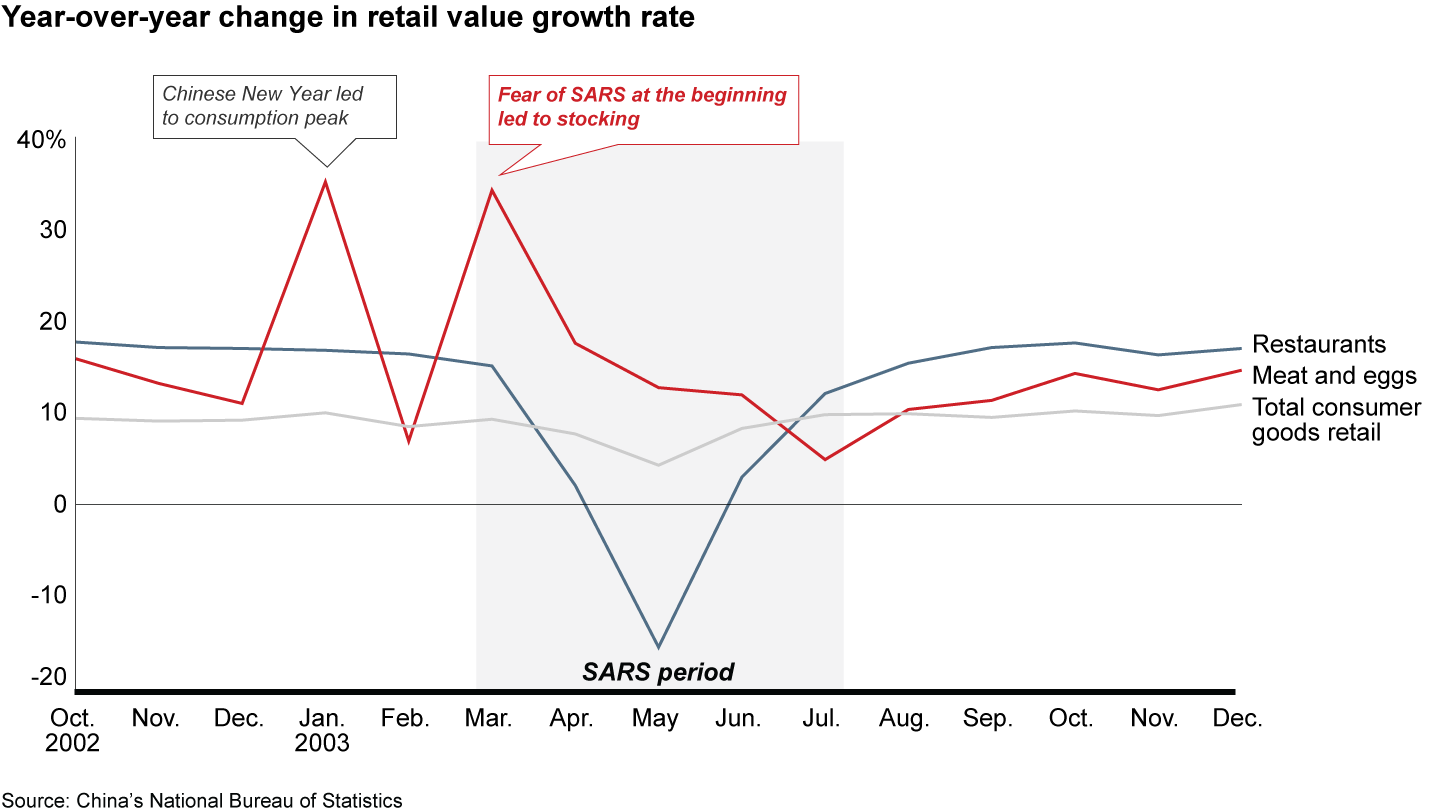
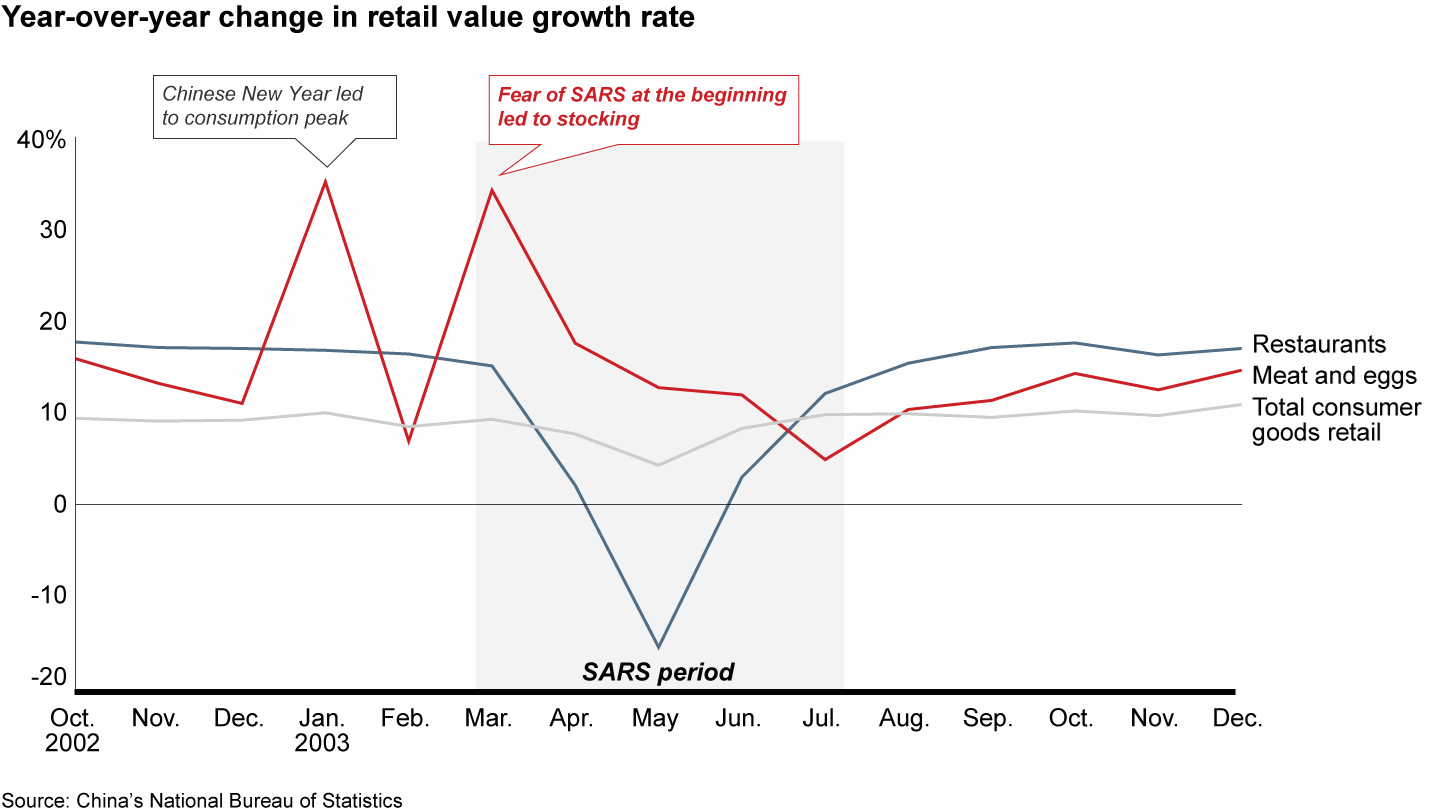
During SARS, restaurants took the largest hit, with year-over-year value growth rate plunging more than 30 percentage points during the peak of the outbreak, as the government canceled its Labor Day holiday and diners stayed home to avoid large crowds. However, restaurants quickly recovered, returning to preoutbreak levels almost immediately after the outbreak passed.
China’s overall retail channel was less affected, but meat and egg sales spiked for about a month at the start of the epidemic as consumers stocked up on supplies.
Impact along China’s food value chain
The coronavirus outbreak promises to have a much larger impact than SARS.
COVID-19 has prompted Chinese authorities to take sweeping quarantine measures to contain it. These efforts include the temporary shuttering of restaurants and fresh food markets, as well as travel restrictions that have affected meat transportation, slaughtering and processing operations (see Figure 2).
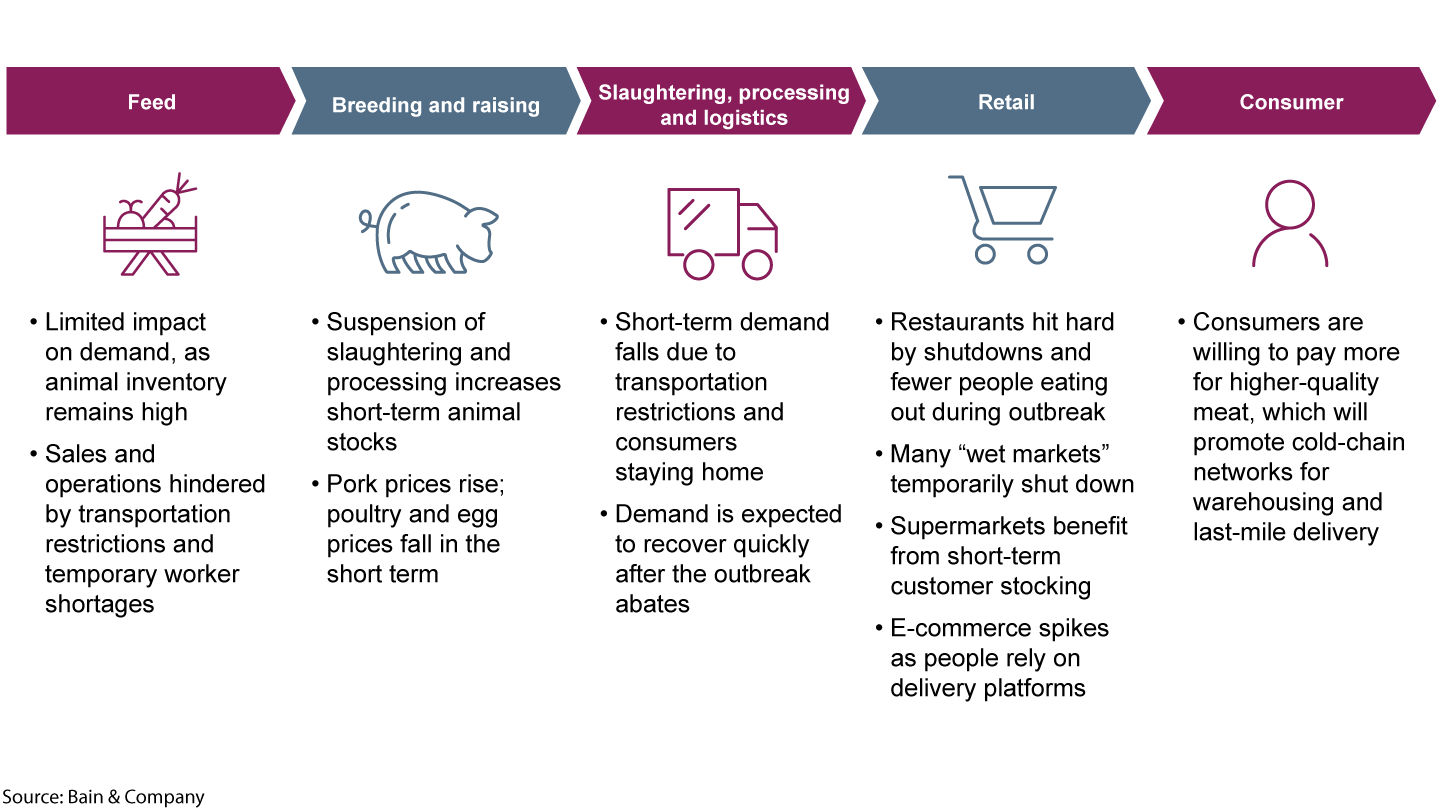
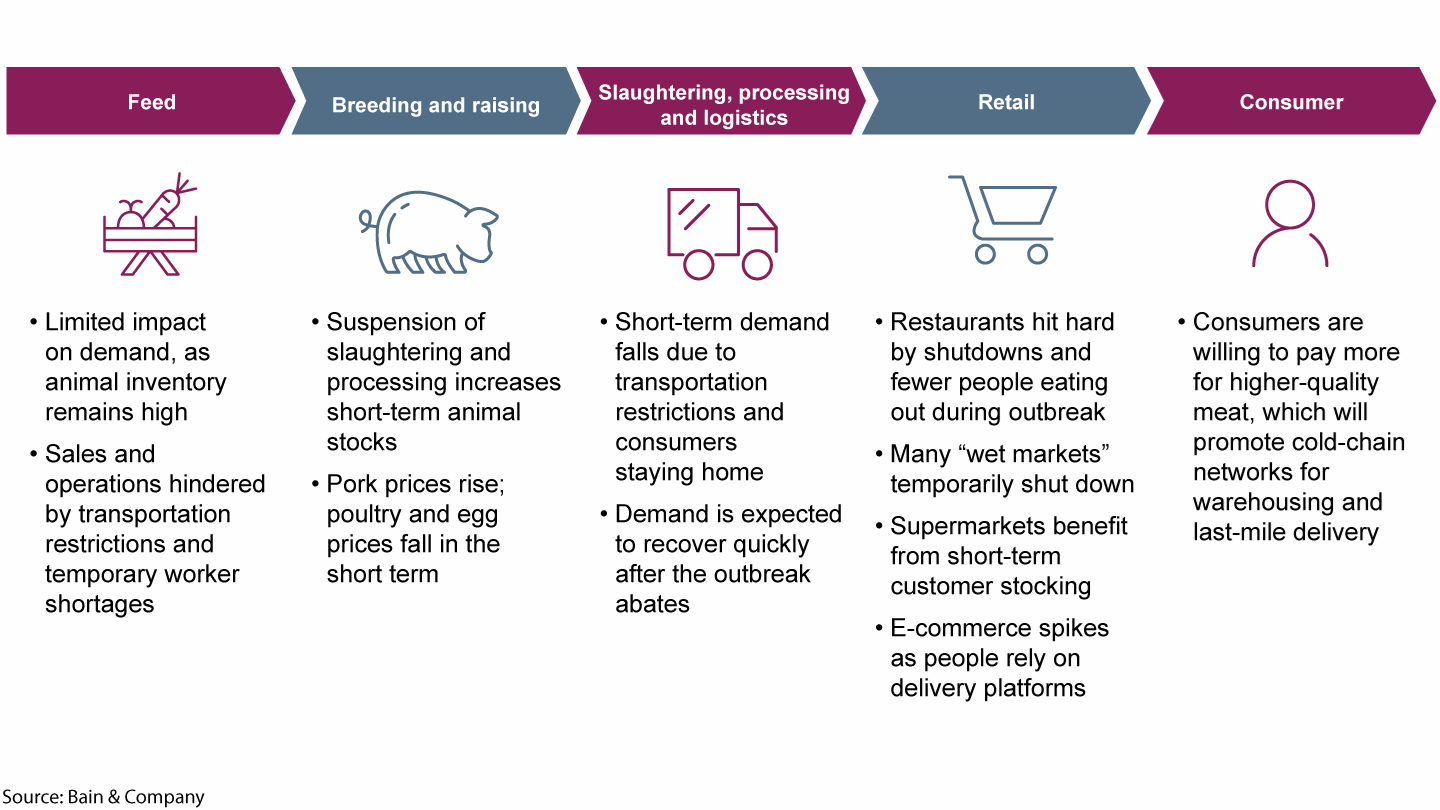
In retail, restaurants saw the sharpest declines: The segment was down more than 50% during Chinese New Year, a peak consumption period in the country, and into February as consumers stayed home.
Outdoor food markets known as “wet markets,” similar to the one where the outbreak began, have also been hit hard, as most were temporarily shuttered amid the outbreak. While some markets outside of Wuhan are reopening, the impact promises to be long term, because we expect much stricter hygiene regulations and enforcement to reshape the segment, and smaller specialty shops give way to broader integration with larger food retailers.
Hypermarkets and supermarkets saw a short-term spike in sales, as more consumers opted to eat at home and stocked up on food supplies. Fresh food sales even doubled at some leading retailers during the Chinese New Year sales period.
Volume rose three times at leading e-commerce food delivery platforms in February, when many consumers opted to stay home. This is likely to accelerate a longer-term shift from offline to online sales in fresh food, which stood at only 3% before the COVID-19 outbreak.
Meat slaughtering, processing and logistics operations face short-term challenges due to declining demand during the outbreak, as well as transportation restrictions and the postponement of many workers returning to their jobs after the Chinese New Year. Some companies remain closed, but government initiatives to guarantee daily food supplies, such as granting priority to food trucks on highways and supporting enhanced safety measures at meat processors, are expected to help this segment quickly recover.
Breeding and raising operations will see a short-term increase in the stock of live animals, because retail sales have declined and culling is not needed. This has affected the prices of key animal products (see Figure 3).
- The poultry and egg segments, which represent 20% to 30% of China’s total protein consumption, have faced strong downward price pressure. Weeks into the outbreak, wholesale prices fell 5% to 10% for live poultry and more than 20% for eggs. This partly reflects the short life cycles of chickens and minimal shelf life of eggs, prompting producers to sell off their stocks at a time when demand was also down, as consumers stayed home while restaurants and markets were closed.
- Pork, which makes up 40% to 50% of the country’s protein consumption, saw wholesale prices rise around 10%. That hike comes on top of already high prices due to the 2018–2019 African swine fever outbreak, which led to the mass culling of pig stocks. Still, the Chinese government has mitigated more severe shortages during the coronavirus outbreak by releasing reserves of frozen pork into the market and allowing some pork producers to resume work after implementing protective measures against the spread of the coronavirus.
- Prices for beef and lamb have been relatively unaffected, as they comprise just 5% to 15% of total protein consumption.
Demand for animal feed will change little, as live animal inventory remains high. Unlike previous outbreaks like the African swine fever, there are no plans for culling in the wake of COVID-19. However, sales and operations have been disrupted by travel restrictions and the delay of employees returning to work.
Key trends transforming China’s food chain
The COVID-19 epidemic, coming on the heels of the bird flu and African swine fever outbreaks, will further accelerate the transformation of China’s food supply chain, especially animal products. Here are four themes spurring this transformation.
Acceleration of cold-chain network development. The rise of e-commerce food channels and the desire for higher-quality food after COVID-19 have boosted the need for a more robust cold-chain network. As consumers become more willing to pay a premium for fresh, high-quality meat, improving the warehousing and last-mile delivery options will be paramount.
Industry consolidation and vertical integration. More attention on food safety will benefit larger players that can invest in modernizing production lines to standards common in the US and Europe, including more refrigeration (see Figure 4). Larger players will also further vertically integrate throughout the value chain to give them more control over raw material prices, quality and supplies. These factors will put smaller players with weak cash positions out of business.
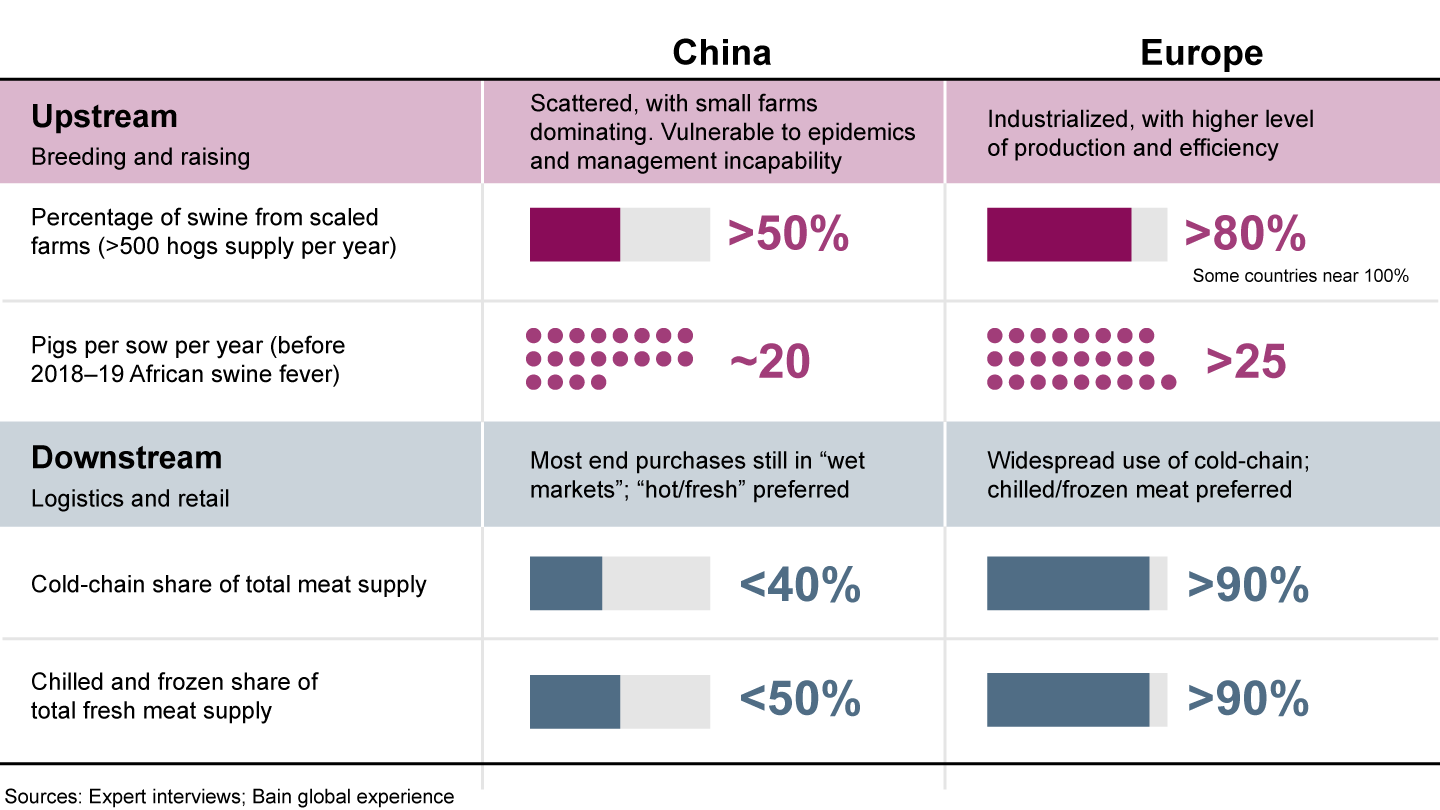
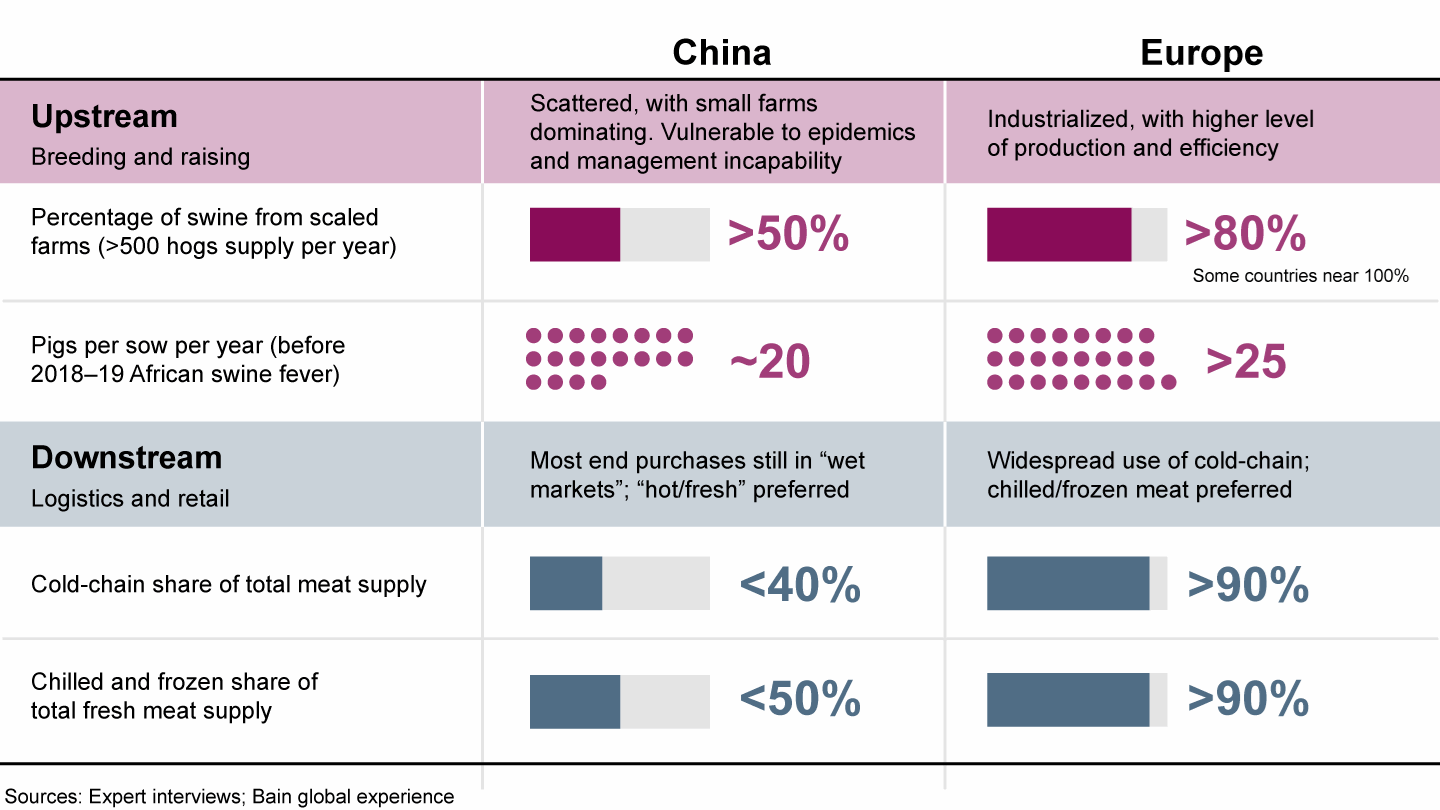
Stricter food safety regulations and enforcement. Chinese authorities will shift toward food-safety standards more in line with European regulations, which cover the whole value chain and include more robust food tracing and a more mature alert system.
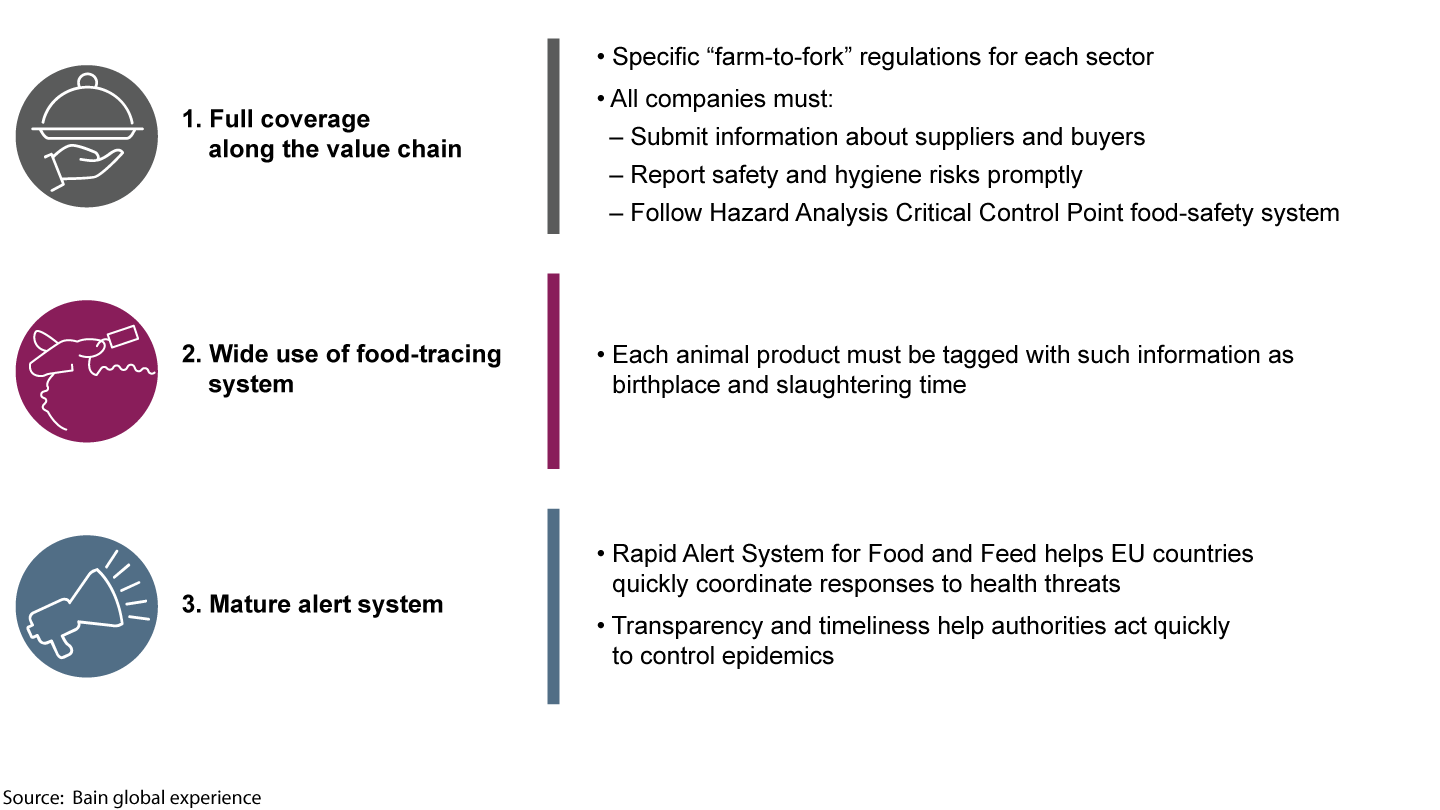
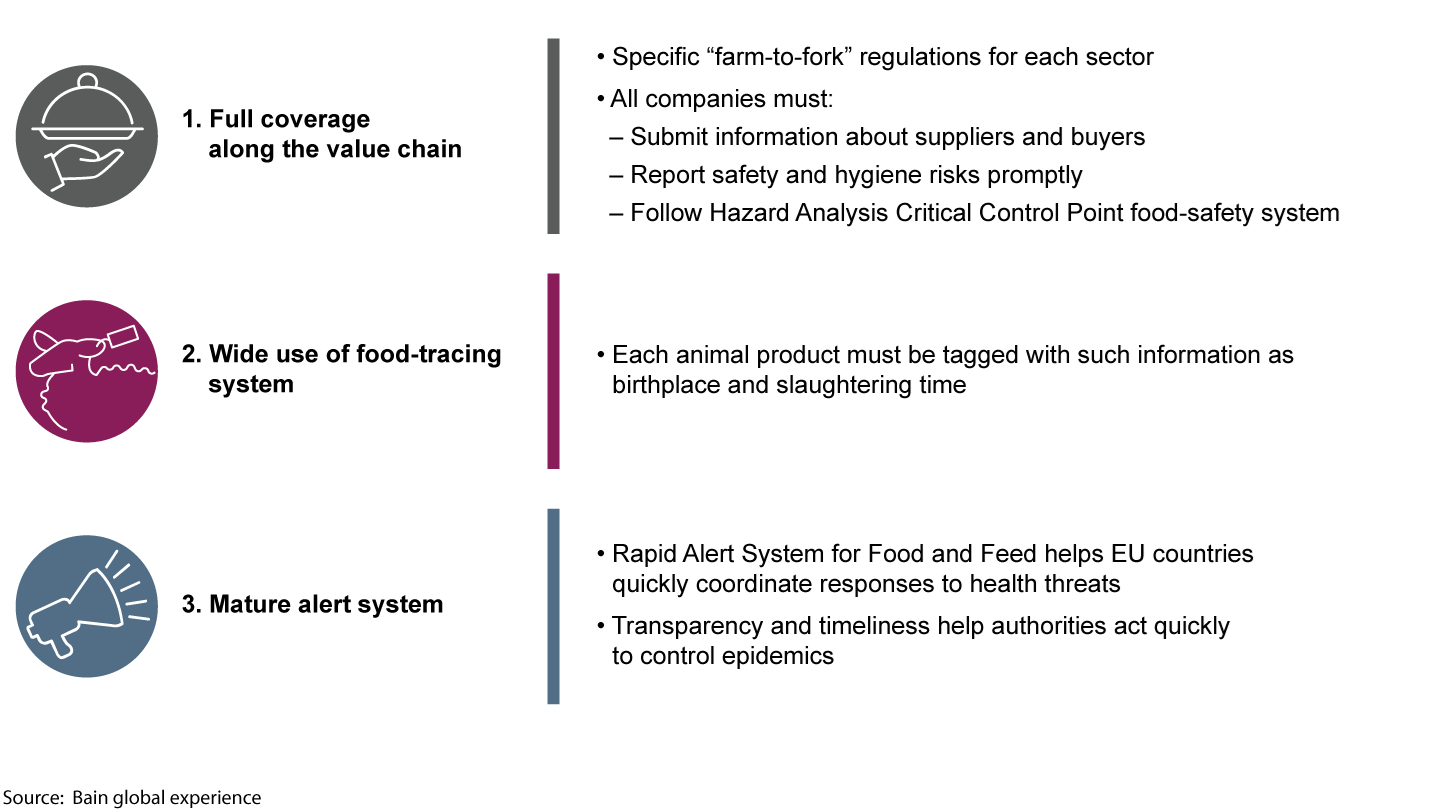
Quicker shift toward digitalization and automation. Until now, the prevalence of small farms in China’s agriculture industry has slowed the adoption of digital and automated technologies. But with the increased attention to food safety after recent outbreaks, stricter regulations and industry consolidation will combine to hasten the adoption of these technologies.
How food and agricultural companies can respond
While the total impact of the outbreak on China’s food sector is yet to be determined, companies can take steps in the short, medium and long term to respond to the challenges and opportunities ahead.
Take short-term steps to navigate through the crisis. To start, companies should implement strict protective measures to ensure the safety of their workers and prevent additional outbreaks. These efforts can improve team morale and reinforce a commitment to quality control.
Next, companies should look for opportunities to cut costs and manage cash. Companies can seek savings in selling, general and administrative expenses (SG&A) or in indirect procurement costs, such as short-term expansion, while profits are lower. Executives should plan for the worst and prepare a “Plan B” that includes things such as financing options or different supply chain solutions.
Identify medium-term opportunities for inorganic growth. Begin by setting a clear strategy based on the company’s future ambition. Identify key capability gaps to reach that ambition, and allocate scarce resources to fill them—either by building the capabilities internally or looking at M&A options.
Then, identify key adjacencies for potential M&A, such as cold-chain logistics. Within each sector, some incumbents face short-term challenges, which may present an opportunity to buy. However, don’t make an acquisition solely based on price. Make sure a target fits the company’s strategy.
Invest in long-term initiatives to embrace the transformation. Double-down on technology that improves food safety and quality control. As regulations become stricter, stay ahead of the curve. Specifically, focus on investing in inspection protocols, devising quarantine procedures and building a robust tracing system.
It also pays in the long term to diversify and balance your product portfolio to increase resilience against future risks. For example, diversify the types of animals bred, or stagger raising periods. To avoid losing focus on your core, build out first from close adjacencies that may share key capabilities.
This is a challenging time for China’s food producers. Companies that make the right moves now will be best positioned to thrive in a market with tougher regulations and changing customer expectations.
The authors would like to thank Yue Chen, Josh Zhu and Rock Zhang for their contributions.
Thomas Luedi and Helen Liu are Bain & Company partners based in Shanghai.

Coronavirus Insights
The global Covid-19 pandemic is exacting a terrible human toll and menacing the world economy. Across industries, companies should act now to protect their employees and customers—and prepare now for the world beyond coronavirus. Explore our Insights page to filter by industry.